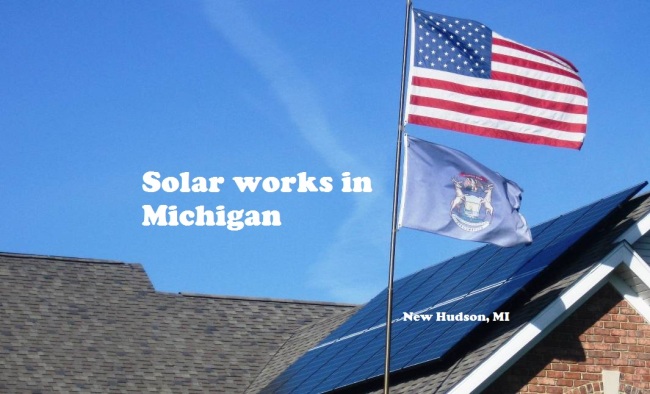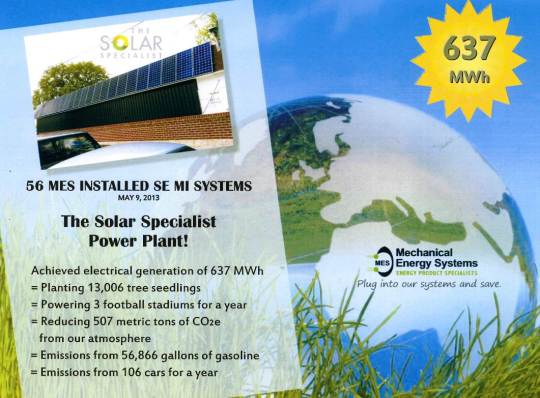
The most common phrase we hear on a daily basis is that solar is not a practical application in a wintery grey state. We disagree and so do thousands right here in SE Michigan.
We don’t get a lot of sunlight compared to other states here in Michigan but we get enough to cover all our needs, how much more do we need? In truth panels operate more efficiently in cool states than in hot states.
Some readers may immediately dismiss our perspective because we are a solar company and we survive by installing solar. Sounds simple but installing solar since 1985 has not been a walk in the park. We live and breathe solar not only because we believe in it but because we know it works. Decades of positive feedback and referrals from happy homeowners using clean, renewable solar energy is a positive place to be and we want to provide this opportunity to anyone who is interested in taking control of their energy generation.
Our first adapters were Michigan Engineers. They crunched the numbers (over and over in every possible scenario), put their money into solar and are happy with their return. All the non-Engineer homeowners have had the same experience.
In the last three years we have installed over 80 solar electric systems and collectively we have generated over 900 MWh of electricity. This is the equivalent of:
- Planting 16,282 tree seedlings
- Powering over 4 football stadiums for 1 year
- Reducing 635 metric tons of CO2e from our atmosphere
- The emissions from 71,188 gallons of gasoline
- The emissions from 132 cars for a year
Many of these homeowners do not pay a monthly electric utility bill and some actually get a check back from the utility company at the end of the year. No one is unhappy with their system; in fact some are removing all gas appliances, installing geothermal and plugging new EV cars into their homes.
Imagine, these results have occurred in only in the last three years. If you could measure how many BTU’s we have generated with all our solar thermal systems; water heating, space heating and pool heating systems over the decades these numbers would be amazing.
It is only recently that we have been able to monitor and record all of our products true generation and most of them even have a mobile app to monitor remotely. Numbers like this are great because they provide measured metrics that can be compared to other fuel sources providing solid data that the skeptics have a much harder time arguing against.
Solar electric generation can now be monitored across the state, the country and the world demonstrating how solar functions in every climate in real time. Inverters that convert the DC electricity to AC, so it can be grid tied and provide a home with useable power, now send out wireless reporting of generation in real time from the home location to the manufacturers monitoring website.
Panel efficiencies are always improving as well as the wattage per panel. A 250W @18% efficiency panel of 2008 is now 335W @22% efficiency. Mind you, these are top of the line efficiency panels. There are still plenty of 14% and 15% efficient panels around, budget dictates the homeowners’ choices, but now there is choice. Some panel companies are aiming for 50% efficiency but we are not there yet.
With always rising utility bills, Michigan’s growing dependence on imported coal costing billions, asthma and other preventable illnesses, clean energy will become an application more and more will choose. It works in Michigan. How much was your electric bill five years ago? What do you think it will be in another five?
You don’t have to listen to us. Watch customers talk about their system on YouTube, unscripted and unrehearsed. Solar homeowners love talking about their systems, we like hearing it. My favorite are retire homeowners in Washington, MI and Livonia, MI. We recorded these for the National Solar Tour two years ago. The National Solar Tour is the first Saturday of October every year.
The next time someone tells you solar does not work in Michigan, first ask them if they have a system… I’m betting NOT, and then ask them if they know someone who has one… ditto… and ask them where they got their information. I’m sure they have not crunched the numbers or talked to people using it daily. Most data the skeptics quote was from the 1970’s, which was accurate back then for PV (not solar thermal), but things have changed over almost four decades.
Even if our state does not adopt a higher renewable energy portfolio I am confident that there are enough people out there using solar today who talk and share their experiences, their utility bills and their mobile app details with their neighbors, friends and family, that solar will continue to grow right here in Michigan, because it does work. We don’t get much sun but we get enough.


Written
on June 12, 2013